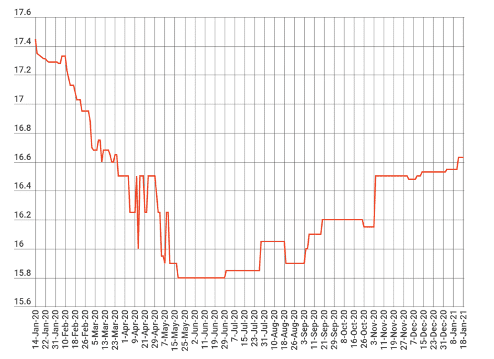The Australian carbon spot price climbed to $16.63 per tonne on Monday, a 10-month high, as pressure continues to grow for the Morrison Government to commit to a more ambitious net-zero emissions target.
The carbon spot price has grown 5% from a 12-month low of $15.80 recorded over May-June of last year, recovering to pre-COVID levels last seen in February to March 2020.

The prospect of Australia setting a more ambitious long-term emissions target has triggered a bullish outlook for carbon offset prices, driven by the return of the United States to the Paris Agreement, the likelihood of stronger climate action by the Biden administration following recent Senate runoff elections in Georgia, and market optimism ahead of the postponed Conference of the Parties (COP 26) – now to be held in Glasgow in November.
As the threat of punitive international action grows – such as carbon border fees or quotas on carbon-intensive goods into Europe and the US – the writing is therefore on the wall for Australia to fall into line with the net-zero objectives of the Paris Agreement, with a net-zero target likely to be the lesser of two evils for the government to avoid any further muddying of its relationships with key export markets.
Domestically, the pressure also continues to mount on the federal government, with Independent MP Zali Steggall’s Climate Change Bill to be considered by parliament in 2021, after being delayed due to COVID-19.
The Victorian Government is also expected to legislate its interim emissions targets by 31 March, with the government’s independent expert panel recommending targets of 32-39 per cent on 2005 levels by 2025 and 45-60 per cent on 2005 levels by 2030, on a pathway to net zero emissions by 2050.
As we enter a federal election year (late 2021 through to mid-2022), we therefore view a net-zero target as the bare minimum course of action, with the federal government unlikely to be able to hold its finger in the dyke for much longer.
While debate may continue over the design of long-term emissions reduction policy, we continue to view the setting of a net-zero target as a key first step. Irrespective of the policy mechanism ultimately deployed, the destination is currently more important than the mode of transport to get there.
In particular, the setting of a long-term emissions reduction target is the missing piece in the government’s climate policy framework, with a transparent goal critical to transition Australia’s largest emitting facilities toward net-zero emissions.
Amid a recent surge in carbon neutrality pledges from corporate Australia, many businesses are beginning to explore the local offset market to offset the emissions they cannot cut, with voluntary demand for carbon offsets doubling over the past two years.
By 2030, voluntary demand from industry is forecast to grow beyond 2 million Australian Carbon Credit Units (ACCU) offsets per year, as large-emitting companies look for ways to meet their newly established net-zero emissions goals.
The relative value of internal versus external abatement (offsets) is therefore an increasingly important question.
We continue to forecast higher ACCU prices as Australia strengthens its emissions reduction ambition. In particular, the Paris Agreement is a key driver of our long-term offset price expectations, with our long-run price forecasts underpinned by the cost and availability of external offsets to meet a 1.5-2°C carbon budget to 2050.
Against our alternative price forecasts, today’s ACCU prices therefore represent value for early movers, particularly high emitting companies taking voluntary action, with current prices trading at a notable discount.
This article is published under RepuTex’s Australian Carbon Market Intelligence service. To learn more please click here.










